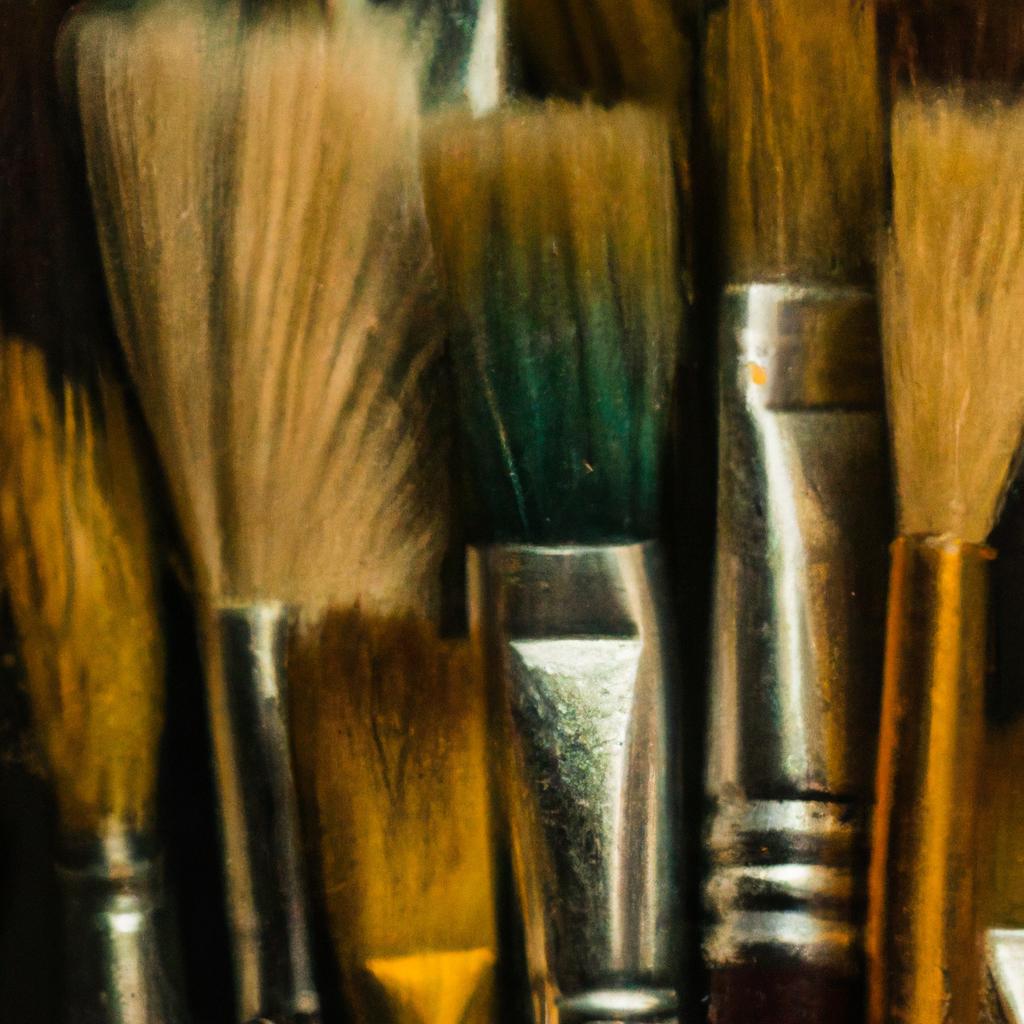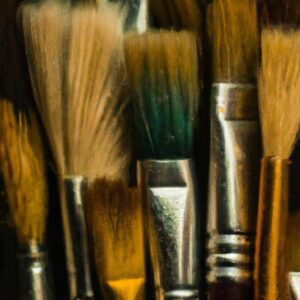Exploring Texture in Painting: Techniques and Applications
Texture is a core component of painting that often gets overlooked. From the brush strokes of the Renaissance to the splattered expressionism of the post-war era, texture has been used to convey meaning, add depth, and create atmosphere across centuries of artworks. In this guide, we explore the history, techniques, and applications of texture in painting.
Introduction: Why Explore Painting Texture?
Texture creates a unique appeal and sensory experience that lifts paintings off the canvas and into the viewer’s imagination. It can be used to convey emotions, create focus, and establish a mood for both viewers and painters alike. By exploring texture in painting, we can discover new ideas, techniques, and potential applications to bring our artwork to the next level.
History of Texture in Painting
Texture has been explored in art since both Ancient Greece and the Renaissance era, when it was used to create contrast between shadows and highlights. During the Baroque period, texture was used to emphasize movement and create drama, while during the Impressionist period texture was used to capture light and color. In the Modern art era, texture was given more prominence, with movements such as Expressionism further exploring its use for emotional impact.
Today, the use of texture continues to evolve, and can be found in many different styles and forms. From abstract florals to more expressive oil paintings, texture is an integral part of how paintings communicate.
History of Texture in Painting
Texture, the visual illusion of physical dimension and tactile quality in two-dimensional art, has an integral role in traditional painting. Texture can be used to evoke a sense of depth and create mood or atmosphere in a painting. To understand texture in painting, it’s important to look at its history and how it has evolved over time.
The use of texture in paintings is thought to have originated with the cave paintings of early humans. The first artists used the textures of stone walls to create their own individual pictorial stories, rendering stripes, circles and other forms of abstract designs in stone. Over time, these artists began to incorporate natural elements such as dirt, mud and sand into their paintings, providing definition and texture to their works.
The beginning of the Renaissance in Europe during the 14th century marked a major shift in the use of texture in painting. In this period, painters sought to render the textures of nature more accurately on the canvas. This was accomplished by adding natural elements like rust and sand to the paint, which created a unique visual effect. As the Renaissance progressed, artists began to explore new techniques such as glazing and impasto, which allowed them to create even more lifelike textures on the canvas.
In the 19th century, Impressionism and Expressionism became popular art movements that emphasized the importance of texture in painting. These movements encouraged the use of expressive brushstrokes and vibrant color palettes to create texture and movement in the painting. In the 20th century, modern art movements such as Cubism and Surrealism explored the potential for new textures within painting, emphasizing the psychological effects of texture on the viewer. Today, texture continues to be explored in art, and it remains an essential part of the painting process.
Types of Textures
When it comes to exploring texture in painting, the possibilities are endless. Textures can range from abstract shapes to figurative representations that add an extra layer of meaning to the artwork. Artists use different types of texture to achieve different effects.
Rough textures often appear in the work of painters who want to create a sense of motion or emotion. For example, layered brushstrokes can represent the depths of an emotion, while blotches of paint can signify chaos and disarray. Smooth textures, on the other hand, are often used to convey a sense of calmness or order.
Textured paintings can also feature a variety of textures such as chiaroscuro (or light and dark), glazes, sfumato (or smokey), and impasto (or thick layers). Each of these textures can be used to give the painting its own unique look and feel. For example, chiaroscuro can be used to create a sense of drama, whereas glazes can add richness and depth.
The type of texture chosen by the artist is dependent on the emotional impact they want to create. For instance, a textured landscape painting might use rough textures to evoke feelings of ruggedness, while a still life painting might use smooth textures to create a sense of peace and tranquility.
By understanding the different types of textures possible in painting, and how each can be used to add meaning to a piece, you can start to explore your own creations with confidence.
Techniques for Creating Texture in Painting
Texture in painting can be created through a variety of methods. Let’s explore some of the most common and popular techniques for adding texture to a piece of artwork.
Brushwork
The simple use of a brush, with different amounts of paint, can create a variety of textures in a painting. For example, short, thick brushstrokes can add an interesting texture to the canvas, while thin, careful brush strokes can create intricate patterns and shapes. Brushwork is also used to create texture in other art forms, such as printmaking.
Palette Knife
A palette knife can be used to create a variety of textures, from thick impasto layers to thin wispy lines. By dragging or pushing the knife across the canvas, the artist can create texture within their work. Palette knife technique can also be used to blend or mix colors together, as well as adding fine details to a piece. It is especially effective when combined with brushwork.
Sponges & Cloths
Using sponges and cloths to apply paint allows the artist to create texture with unusual marks. Wiping and dabbing the painting gives it a unique look with various rough patches and neat edges. This technique is most effective when used in combination with brush and palette knife work, as it adds the final touches to a painting.
Spray Paint
Spray painting adds a unique texture to a painting, as it can produce very textured effects with light or heavy layers. It is often used to create abstract styles of artwork, as well as for graffiti and street art pieces. Spray painting can be used in combination with other techniques to create interesting mixed media works.
Applications of Texture in Painting
Texture serves many purposes in painting. It can be used to add interest or drama to the piece and capture a wide array of emotions. Texture can also be used to add meaning to certain elements and create atmosphere. For example, smooth surfaces can suggest calmness, while rough texture might suggest tension or chaos.
Texture can also be used to imply various textures in real life. For instance, an artist can use brushstrokes or other forms of texturing to suggest the feel of fur on an animal, or the slippery surface of a fish. By manipulating the texture of an artwork, an artist can make the viewer connect more deeply with the image or evoke a specific emotion.
What’s more, texture can be used to create harmony and balance within an artwork. Different textures can be used to draw the viewer’s attention to certain parts of the painting. The artist can also choose to contrast certain textures in order to add depth and complexity to the piece.
Ultimately, texture is an invaluable tool for every painter. It can be used to increase the overall impact of a painting, as well as enhance the message or story being told. With a little practice, any artist can learn to use texture to create expressive and meaningful works of art.
Conclusion
Exploring texture in painting is a critical component of creating dynamic pieces. Texture can be used to convey atmosphere, add depth or bring focus to a piece. There are many different types of textures that can be used in painting, ranging from brushstrokes and ripples to scratches and dents. Additionally, there are many techniques available to create these textures, including palette knife work, complementary texture techniques, wet-on-wet painting and layering. Understanding and using texture is key to creating compelling works of art.
This guide has explored the importance of texture in painting, its history, the different types of textures, techniques for creating them and how they are used in works of art. We hope this information is useful in helping artists create beautiful works of art with texture. To learn more about texture in painting, we recommend exploring the resources below:
- Art Techniques: Exploring Texture by Olive Huang (2020).
- Creating Texture in Painting: A Step-by-Step Guide by John Smith (2020).
- The Art of Textures: Using Different Types of Textures in Your Paintings by Anna Anderson (2021).
comments: 0

